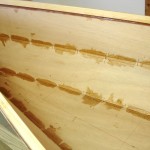Would you like to see a picture of the stitches in my arm? No, I didn’t think so. Actually, they are almost gone, the self-dissolving kind left from a very minor surgery some time ago.
Some stitch-n-glue builders leave the stitches in the boat. They cover the seams with a thick fillet of epoxy, then epoxy soaked fiberglass cloth, all in one pass. One might follow this approach for either of two reasons, to get a good solid seam by applying everything at once, or to build the boat quickly (Build a boat in a week!). Once the epoxy sets around the wires, they’re there to stay. All that can be done is to snip the tails off on the outside, and deal with the detritus in all the rest of the finishing steps.
 The more persnickety builders do the seams in two steps. The first is “tabbing,” securing the spaces between the wires with thin epoxy fillets. Then the wires can be removed and the full length of the seams reinforced. Guess which camp I’m in. Right! Persickety. You win today’s prize.
The more persnickety builders do the seams in two steps. The first is “tabbing,” securing the spaces between the wires with thin epoxy fillets. Then the wires can be removed and the full length of the seams reinforced. Guess which camp I’m in. Right! Persickety. You win today’s prize.
Even this, I did in two stages. I mixed epoxy straight out of the pumps with no fillers. I brushed this onto the seams to allow the raw edges to soak up some glue. Then, I mixed in “wood flour” to thicken the epoxy to a consistency midway between mustard (Dijon, not yellow) and peanut butter. I pressed that into the seams fairing them with a rounded stick (think tongue depressor). I was persnickety about making these extra clean so they won’t need sanding before the cloth layer.
Denatured alcohol (not the drinkable kind) is a good clean up agent for removing epoxy from places it does not belong, such as the handles of my pliers and clamps. Recent reading suggested trying simple white vinegar. Dang! It works better than alcohol. It’s pretty amazing that the stuff we splash on our veggies can remove rust from tools and cut this industrial adhesive. Or, maybe it’s amazing that our digestive pipes handle the solvent?
Well, I won’t be completing this boat in a week, but it will end up prettier than my arm.
Bob,
Did you know there is a method to remove those wires?
We had a informal presentation at our Woodworking club last night by a member. He said, if you leave long enough ends to grab and heat with a torch, that heat will melt the epoxy bond enough to pull the wires in most cases. He also stated to use only copper wire. That if steel wire gets left in the epoxy its almost guaranteed that it will get wet and rust.
Thanks Peter,
That’s a great suggestion. I can see how it would work well. Too late for this boat, but maybe next time. Good reminder about steel and copper too. Thanks!